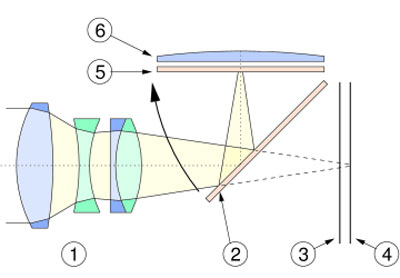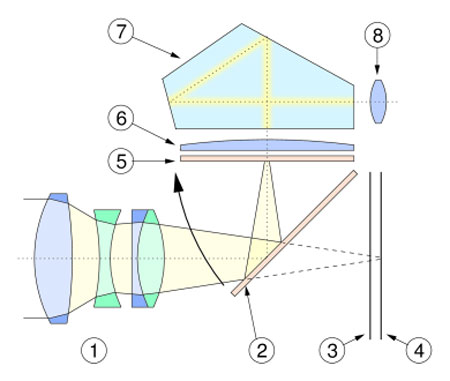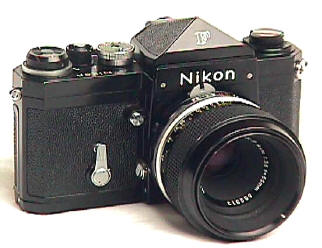Digital Photography from 20,000 Feet
by Wesley Fink on September 25, 2006 12:05 AM EST- Posted in
- Digital Camera
Why the Digital SLR?
SLR cameras have been around for more than 50 years, but it is remarkable how many of those shopping for a digital camera have no idea why the market is moving to the SLR or Single Lens Reflex. Up until the late 1940's the world of hobbyist photography was ruled by 35mm point-and-shoot and rangefinder cameras. These cameras were not really that different from the point-and-shoot cameras that we have today in digital photography, except that they did not have the benefit of all the electronics that are part of today's digital cameras. The cheap point-and-shoots used a fixed focus lens, which meant the lens always shot a certain range (depth-of-field) in focus - no matter whether the subject was in that range or not. The better of these cameras used rangefinders, which were two images from two optics superimposed in the viewfinder. When these two images merged in the viewfinder your subject was in focus. As you can imagine the optics to allow focusing were pretty complicated and expensive to build. However, with a fixed lens that never changed it was possible to design and manufacture some very reliable and affordable rangefinder cameras.
The top end of the amateur photography market, which had embraced 35mm as the "miniature" film standard, then introduced a brilliant idea. Why not manufacture cameras that could use multiple lenses. This would allow the photo hobbyist to use the lens that was best suited for what they were photographing - like a wide-angle lens for interiors, or a telephoto for sporting events and far away subjects. Companies like Leica and Contax pioneered these interchangeable lens rangefinder cameras in the 1930s. After World War II, German camera companies resumed camera manufacturing. Japan, which had manufactured quality optics for a more limited market before WWII, also began making quality interchangeable lens rangefinders. Japanese companies like Canon, Aries, and Nikon championed cameras with changeable lenses.
The ability to change lenses was a great idea, but the execution was anything but simple. Viewfinders started having multiple frames engraved for the different focal lengths like 35mm, 50mm, 85mm. The user had to remember that the tiny square was 85mm. Leica and others had accessory viewfinders that mounted on the flash shoe so you could see about what the lens saw. The problem with the rangefinder is that the viewfinder and the lens never see the same thing. This was not a huge issue with a fixed lens, since the viewfinder could be matched reasonably well to the lens. There were even complicated mechanics that adjusted the viewfinder for "parallax error" on rangefinder close-ups. But with interchangeable lenses the situation became very complicated.

The first popular solution to this problem was the German Exacta, fist produced in 1936. The Exacta had a waist level-finder and a flipping 45-degree mirror. With a flipping mirror, you could look through the lens for composition and focusing - seeing the same view as the lens. You looked at the image from above the camera (5), the image was backwards (as in a mirror image), and the mirror was either manually reset or later reset automatically when winding the film, but the view on the ground glass was the same as any lens (1) mounted on the camera.
In the 1950's the Japanese pioneered further development of the SLR design. A roof pentaprism first appeared on an East German Contax S announced in 1949, but the Japanese camera industry refined and perfected the idea. Asahi developed the Asahiflex in 1952, and in 1954 the Asahiflex IIB. In 1957, Asahi Pentax introduced the fixed pentaprism and the right-hand thumb wind lever. Minolta introduced their first SLR, the SR-2, in 1958. Nikon, Canon and Yashica introduced their first SLRs in 1959 (the F, Canonflex, and Pentamatic, respectively).

The diagram shows how the light passes through the SLR lens assembly (1), is reflected by the mirror (2) and projected on the matte focusing screen (5). Using a condensing lens (6) and internal reflections of the mirrored roof pentaprism (7) the image appears in the eyepiece (8). When an image is taken, the mirror flips up as the arrow indicates, the shutter (3) opens, and the image is projected onto the film or digital sensor (4) The image at the film or sensor is exactly the same as on the focusing screen. [Image from Wikipedia.]
By the early 1960s the basic form of the SLR had evolved to what we know today, as you can see in this photo of the original Nikon F SLR.

Refinements have continued to expand the usefulness of the SLR design. The Topcon RE Super and Asahi Pentax Spotmatic pioneered through the lens metering in the early 60's. Auto exposure was first seen in the Pentax Spotmatic F in 1971, and it was popularized with the Canon AE-1 Program in 1976. Pentax made a limited attempt at autofocus in 1981 with a 35-70 f2.8 lens for the Pentax ME-F. A few years later, Minolta brought out the first real autofocus camera, the MAXXUM 7000, in 1985. The autofocus auto-everything Maxxum 7000 was wildly popular and made autofocus a virtual requirement on future SLR designs.
SLR cameras have been around for more than 50 years, but it is remarkable how many of those shopping for a digital camera have no idea why the market is moving to the SLR or Single Lens Reflex. Up until the late 1940's the world of hobbyist photography was ruled by 35mm point-and-shoot and rangefinder cameras. These cameras were not really that different from the point-and-shoot cameras that we have today in digital photography, except that they did not have the benefit of all the electronics that are part of today's digital cameras. The cheap point-and-shoots used a fixed focus lens, which meant the lens always shot a certain range (depth-of-field) in focus - no matter whether the subject was in that range or not. The better of these cameras used rangefinders, which were two images from two optics superimposed in the viewfinder. When these two images merged in the viewfinder your subject was in focus. As you can imagine the optics to allow focusing were pretty complicated and expensive to build. However, with a fixed lens that never changed it was possible to design and manufacture some very reliable and affordable rangefinder cameras.
The top end of the amateur photography market, which had embraced 35mm as the "miniature" film standard, then introduced a brilliant idea. Why not manufacture cameras that could use multiple lenses. This would allow the photo hobbyist to use the lens that was best suited for what they were photographing - like a wide-angle lens for interiors, or a telephoto for sporting events and far away subjects. Companies like Leica and Contax pioneered these interchangeable lens rangefinder cameras in the 1930s. After World War II, German camera companies resumed camera manufacturing. Japan, which had manufactured quality optics for a more limited market before WWII, also began making quality interchangeable lens rangefinders. Japanese companies like Canon, Aries, and Nikon championed cameras with changeable lenses.
The ability to change lenses was a great idea, but the execution was anything but simple. Viewfinders started having multiple frames engraved for the different focal lengths like 35mm, 50mm, 85mm. The user had to remember that the tiny square was 85mm. Leica and others had accessory viewfinders that mounted on the flash shoe so you could see about what the lens saw. The problem with the rangefinder is that the viewfinder and the lens never see the same thing. This was not a huge issue with a fixed lens, since the viewfinder could be matched reasonably well to the lens. There were even complicated mechanics that adjusted the viewfinder for "parallax error" on rangefinder close-ups. But with interchangeable lenses the situation became very complicated.

The first popular solution to this problem was the German Exacta, fist produced in 1936. The Exacta had a waist level-finder and a flipping 45-degree mirror. With a flipping mirror, you could look through the lens for composition and focusing - seeing the same view as the lens. You looked at the image from above the camera (5), the image was backwards (as in a mirror image), and the mirror was either manually reset or later reset automatically when winding the film, but the view on the ground glass was the same as any lens (1) mounted on the camera.
In the 1950's the Japanese pioneered further development of the SLR design. A roof pentaprism first appeared on an East German Contax S announced in 1949, but the Japanese camera industry refined and perfected the idea. Asahi developed the Asahiflex in 1952, and in 1954 the Asahiflex IIB. In 1957, Asahi Pentax introduced the fixed pentaprism and the right-hand thumb wind lever. Minolta introduced their first SLR, the SR-2, in 1958. Nikon, Canon and Yashica introduced their first SLRs in 1959 (the F, Canonflex, and Pentamatic, respectively).

The diagram shows how the light passes through the SLR lens assembly (1), is reflected by the mirror (2) and projected on the matte focusing screen (5). Using a condensing lens (6) and internal reflections of the mirrored roof pentaprism (7) the image appears in the eyepiece (8). When an image is taken, the mirror flips up as the arrow indicates, the shutter (3) opens, and the image is projected onto the film or digital sensor (4) The image at the film or sensor is exactly the same as on the focusing screen. [Image from Wikipedia.]
By the early 1960s the basic form of the SLR had evolved to what we know today, as you can see in this photo of the original Nikon F SLR.

Refinements have continued to expand the usefulness of the SLR design. The Topcon RE Super and Asahi Pentax Spotmatic pioneered through the lens metering in the early 60's. Auto exposure was first seen in the Pentax Spotmatic F in 1971, and it was popularized with the Canon AE-1 Program in 1976. Pentax made a limited attempt at autofocus in 1981 with a 35-70 f2.8 lens for the Pentax ME-F. A few years later, Minolta brought out the first real autofocus camera, the MAXXUM 7000, in 1985. The autofocus auto-everything Maxxum 7000 was wildly popular and made autofocus a virtual requirement on future SLR designs.










81 Comments
View All Comments
Zaitsev - Monday, September 25, 2006 - link
That was a very interesting article. I've always wanted to learn more about cameras and photography, in the hopes of making it a hobby once the time and money is available. So thanks for explaining the background info for noobs like me :) I'll be looking forward to the rest of the series.